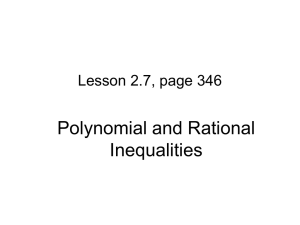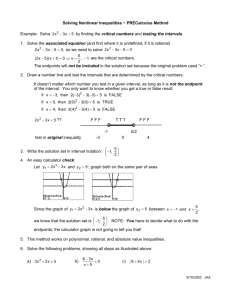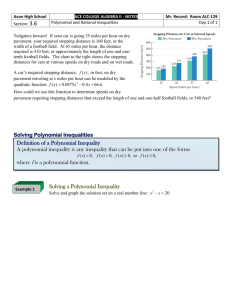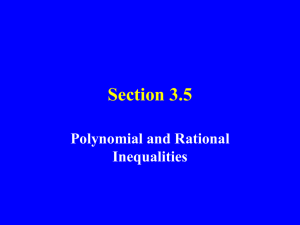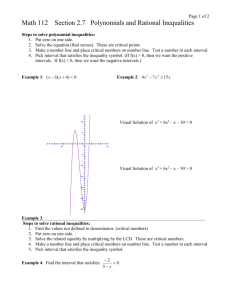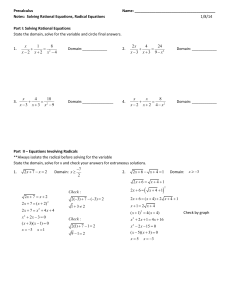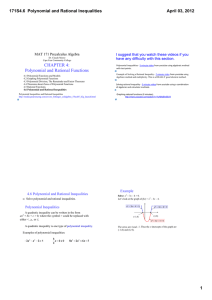CHAPTER TWO
advertisement
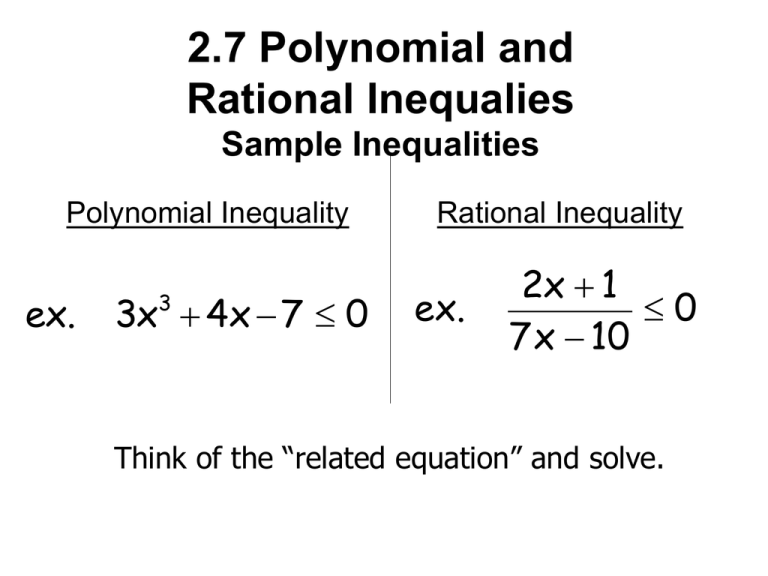
2.7 Polynomial and Rational Inequalies Sample Inequalities Polynomial Inequality ex. 3x 4x 7 0 3 Rational Inequality ex. 2x 1 0 7x 10 Think of the “related equation” and solve. Review: Find the zeros of f(x) = x³ + x² - 6x. The values of 0, -3, and 2 are considered to be boundary points. Boundary points are values of x for which P(x) is undefined or equal to zero. Polynomial Inequalities • A quadratic inequality can be written in the form ax2 + bx + c > 0, (where the symbol could be replaced with either <, <, or >.) • A quadratic inequality is one type of polynomial inequality. Examples of Other Types: 3 4 2 2 x x 2 4 x60 4 8x 2 x 6 x 5 3 2 Given the following graph of f(x), give interval notation for x-values such that f(x)>0. a ) ( 3, 1) (0, 2) (4, ) b) ( , 3) ( 1, 0) (2, 4) c) ( , ) d ) ( 3, 4) Steps for Solving Polynomial Inequalities 1. Rewrite the inequality so that there is a zero on the right side. 2. Find the x-intercepts. (Solve the polynomial equation.) 3. The x-intercepts divide the x-axis into intervals. Select test values in each interval and determine the sign of the polynomial on that interval. 4. The solution will be those intervals in which the function has the correct signs satisfying the inequality. Start up Example – Watch & listen. Solve: 4x3 7x2 15x. Example continued 4x3 7x2 15x • The zeros divide the x-axis into four intervals. We need to determine the sign of the polynomial in each interval. Interval Test Value Sign of f(x) Since we are solving 4x3 7x2 15x 0, the solution set consists of only two of the four intervals, those in which the sign of f(x) is negative. Solve and graph the solution set: x2 – x > 20. Interval Test Value Sign of f(x) Solve and graph the solution set on a real number line: x3 + 3x2 < x +3 Interval Test Value Sign of f(x) Rational Inequalities • What does the word “rational” mean? In other words, what can you expect in these problems? Answer: A FRACTION! • A rational inequality is any inequality that can be put in the form f(x) < 0, f(x) > 0, f(x) < 0, or f(x) > 0. x3 • Solve 2 0 . x 1 • First, find the domain and determine if f(x) is not defined for any values of x. Example continued • Next, solve f(x) = 0. x3 0 2 x 1 Example continued • The boundary points are 3, 1, and 1. • These values divide the x-axis into four intervals. We use a test value to determine the sign of f(x) in each interval. Interval Test Value Sign of f(x) (, 3) f(4) =1/15 (3, 1) f(2) = 1/3 + (1, 1) f(0) = 3 (1, ) f(2) = 5/3 + Example continued x3 0 2 x 1 • Function values are positive in the intervals (3, 1) and (1, ). • Since neither 1 or 3 is in the domain of f, they cannot be part of the solution set. Therefore, the solution set is (3, 1) (1, ). Steps for Solving Rational Inequalities 1. Rewrite the inequality so that there is a zero on the right side. 2. Find the values for which the rational function is undefined and equal to zero. (Values that make zero in the denominator and zero in the numerator.) These are the boundary points 3. The boundary points divide the x-axis into intervals. Select test values in each interval and determine the sign of the polynomial on that interval. 4. The solution will be those intervals in which the function has the correct signs satisfying the inequality. Boundary points that made the function undefined (denominator = 0)will never be included in the solution set. • Solve and graph the solution set: Interval Test Value 2x 1 x 1 Sign of f(x)
